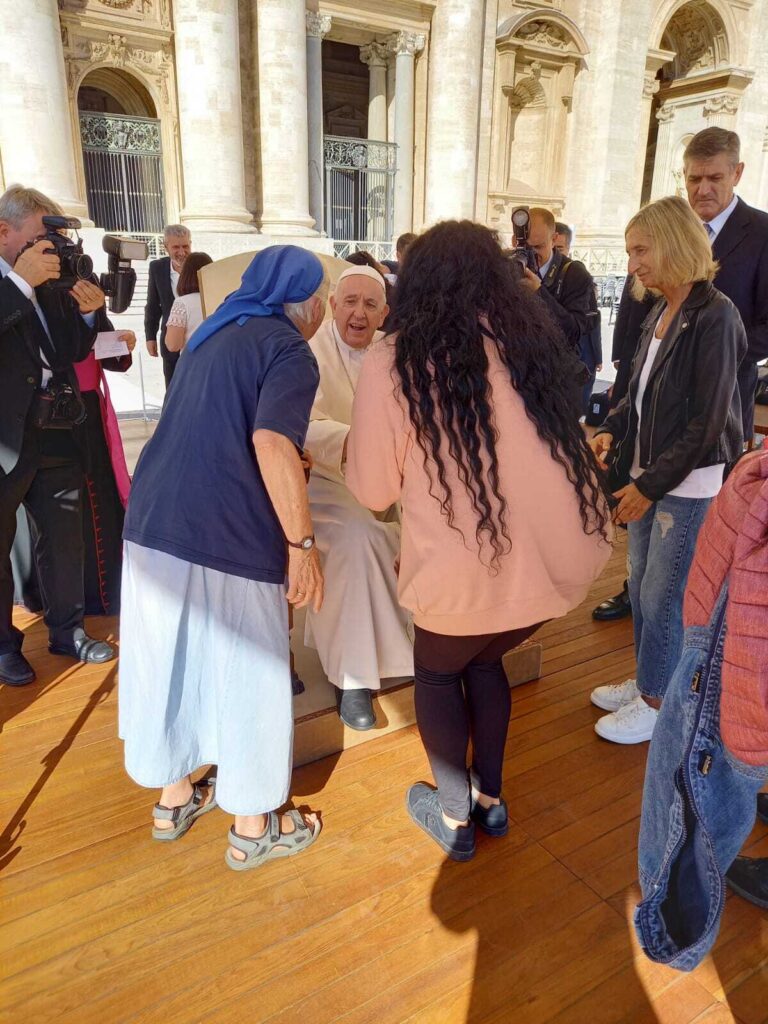The following article originally appeared in La Repubblica, a Rome-based newspaper, on Oct. 17, 2022. The piece, translated from the Italian by Massimo and Sarah Faggioli and Griffin Oleynick, is reprinted here with the permission of its author.
Mostly from Argentina, the women live along the coast, near Rome. The Vatican helped them make ends meet during the pandemic. “Our audience at St. Peter’s makes us feel better,” they say.
On October 6, 2022, Naomi Cabral, a transgender prostitute from Argentina, was found dead in the same hotel room where she used to receive clients. It happened in Torvaianica, a few miles from Rome. Cabral is mourned by a few colleagues and friends—among them Pope Francis, who received her along with other trans people in St. Peter’s Square the previous spring. The roots of that meeting, the first in a series of encounters, go back to the early days of the pandemic.
Torvaianica, March 2020: Standing by the door of the large Church of Beata Vergine Immacolata, a parish overlooking the sea, is a long line of people. Among them are many seasonal workers, both native Italians and new arrivals. None know where their next meal will come from.
The pastor, the Rev. Andrea Conocchia, tries to welcome everyone, but there’s a great deal of need. There are those who ask for help with the rent, those who need medications, those who just want to reload their prepaid cell phones.
In the crowd, an Argentinian transgender person arrives, then a second, and a third. They cannot afford to purchase food, because they no longer have customers. But there’s nothing the parish can do to help: canceled Masses mean that offerings have dwindled. And so, Father Andrea suggests that Cabral and her friends write directly to Pope Francis.
It didn’t take long for Cardinal Konrad Krajewski, the papal almoner, to respond with help paying for food and rent, as well as an invitation to receive Covid vaccines. “We were vaccinated before the Italians!” laughs Marcela De Marco, a Uruguayan trans person.
Grateful for the aid, they asked Father Andrea how they might obtain an audience with the pope. They wanted to thank him, greet him and get to know him. The priest asked Sister Geneviève Jeanningros, a French nun who has worked for years among the buskers and street artists living along the Roman coast. She’s also an old acquaintance of Jorge Mario Bergoglio, later Pope Francis, from his time in Argentina.
After a few days, she replied: “The pope wants to meet everyone.”
The priest was astonished: “‘Everyone means a hundred people!” How would it happen?
A solution presented itself immediately: they could all attend the Wednesday general audience in St. Peter’s Square. On April 27, 2022, a small group showed up at the Vatican: Father Andrea, Sister Geneviève and four Latin American trans people—including Naomi Cabral.
“Pope Francis didn’t judge us—he listened,” recalled Minerva Motta, a Peruvian.
After a few days, Sister Geneviève replied: “The pope wants to meet everyone.”
That day, Claudia Victoria Salas, also from Argentina, brought the pope some empanadas. When another group showed up later, Francis asked: “Where’s Claudia? I want to thank her for the empanadas.”
“For my part, I thanked him for restoring my faith,” Marcela recounted. “He told me: ‘Remember that we are all equal before the eyes of God.’” Since then, the pope has continued sending cards and prayers to trans people. Ever since that first audience, Father Andrea and Sister Geneviève have continued bringing small groups of trans people to visit Pope Francis at least once a month.







This happens without much media attention, but in front of the eyes of thousands of faithful. “The pope’s meeting with a group of trans people was significant,” noted L’Osservatore Romano, the Vatican’s official newspaper.
“I felt special. I saw all the people in the square and I was 20 meters away from the pope,” said Laura Esquivel, a trans woman from Paraguay, at a July audience. “He behaved like an ordinary person. I kissed his hand, he kissed mine.” Now Esquivel would like to return: “The photo didn’t come out well. I had a crooked expression.”
These transgender people have always had strong relationships with God, but less so with the church. “At five in the morning, I always pray to Saint George, my protector, the patron saint of justice,” says Claudia Victoria Salas. In the pews, though, “they give each other the peace sign, then go out and ignore you.” Or worse. “I had lost faith, now I’ve started going to church a little,” says Claudia Valentina Tejerina, from Argentina.
And she specifies: “We are who we want to be, but then there are some who hypocritically hide behind their family.” I asked if her clients were Catholics. “Of course, we are in Italy!” she cuts short with a laugh.
Minerva recounted: “In my country I was a catechist. I participated in a choir. In Europe, I moved away because people look at you with scorn.” Did the meeting with the pope change anything? “Change is internal,” she replied.
“People don’t know that we’ve met the pope, but I feel calmer within myself,” said Claudia Valentina.
“People don’t know that we’ve met the pope, but I feel calmer within myself,” said Claudia Valentina.
After the pandemic began to subside, many trans people resumed prostitution. I asked if they felt the need to make lifestyle changes. “I’m available to do house cleaning. I’ve been a hairdresser and I know how to work in the kitchen,” replied Claudia Victoria. “But they don’t want me.”
According to Marcela, “When you’re trans, all doors are closed to you: church, school, work. People wag their fingers.” Do they feel like sinners? “We are all sinners, and we are all made in the image of God,” replied Claudia Valentina. Marcela added: “Whoever is free from sin throws the first stone, as Jesus said to Mary Magdalene. That’s why my middle name is Magda.”
Last October, Sister Geneviève returned to Rome with another group of trans people. She brought a card with a photo of Naomi Cabral. “Pray, pray, pray,” said the pope, who wanted to keep the photo.
The world discarded her, but he remembers her.




